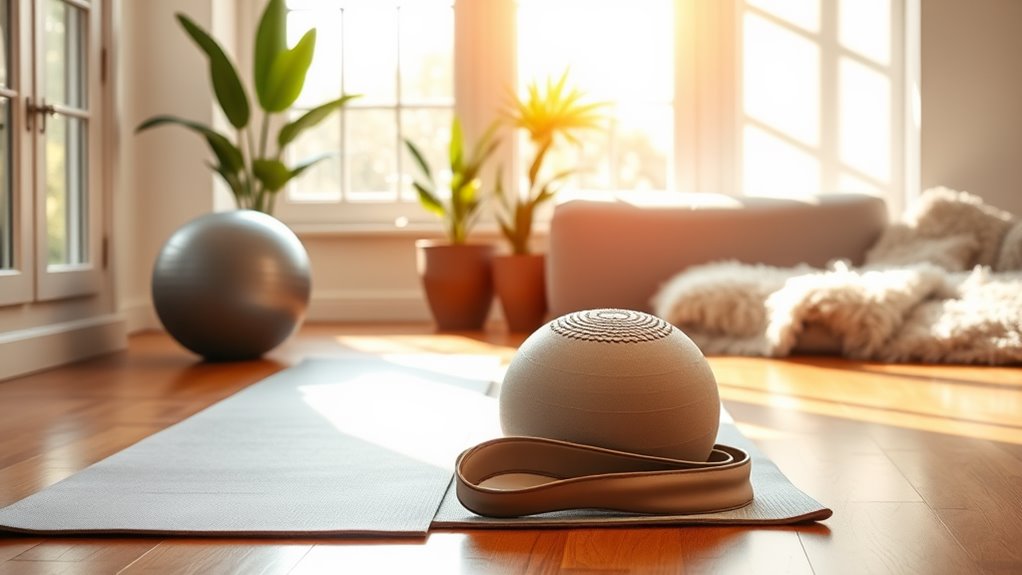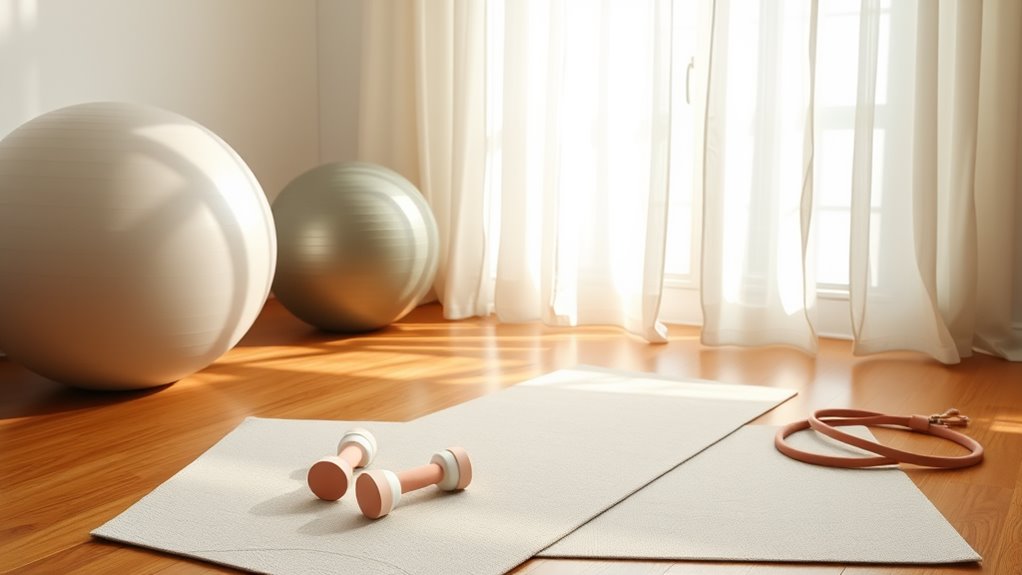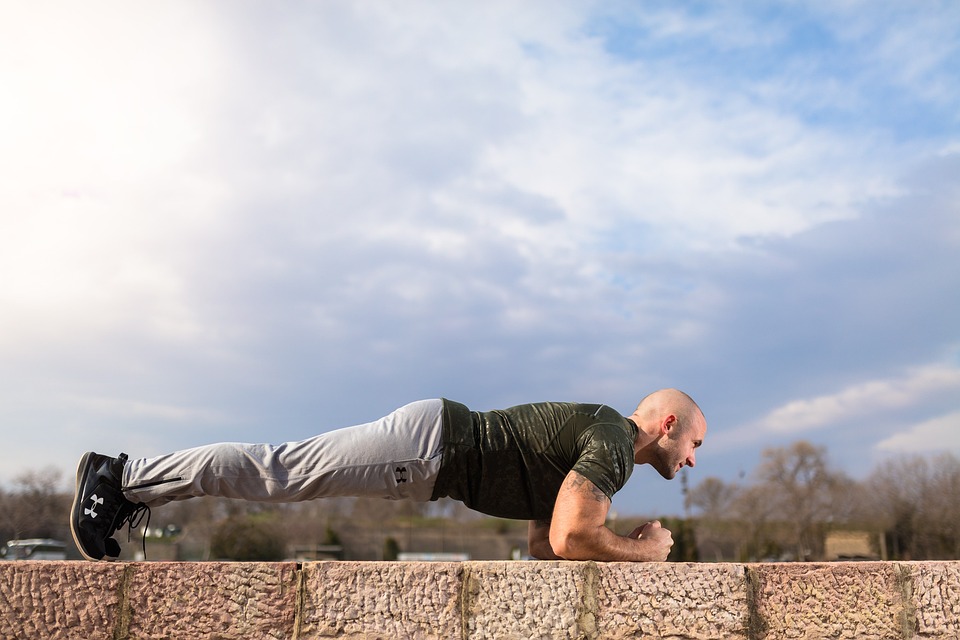
Start your postpartum recovery with gentle exercises that focus on your pelvic floor and core. Begin by practicing diaphragmatic breathing and slow pelvic floor squeezes to enhance stability and relieve stress. Gradually introduce core strengthening moves like Dead Bugs and Glute Bridges. As you build strength, incorporate lower body workouts such as Bridges and Wall Sits, progressing to squats and lunges over time. Walking and swimming are also excellent low-impact options. Verify you get medical clearance before starting any exercise routine. There’s much to gain from safe and effective recovery exercises as you explore further.
Starting Gentle Exercises
After giving birth, it’s essential to ease into postpartum recovery exercises to support your body’s healing. Immediately focusing on pelvic health through pelvic floor exercises is key. Picture squeezing those muscles, as if you’re stopping the flow of urine, holding for 5-10 seconds, then slowly releasing. Do this ten times, three times a day, from the comfort of lying down, sitting, or standing. This empowers you to prevent urinary incontinence and begins the journey to reclaim control over your body’s natural functions.
Incorporating walking into your routine introduces gradual physical activity. Embrace the liberation of short, brisk walks—whether you’re indoors, outdoors, or pushing a stroller. Increase your duration and distance over time, aiming for those invigorating 30-minute walks, five days a week. Such movement helps boost cardiovascular fitness and combat fatigue, uplifting not just your physical state but also your emotional wellness. Engaging in regular exercise can help manage stress levels and promote better coping mechanisms for life’s challenges. Regular exercise linked to reduced anxiety and depression enhances not only your physical well-being but also supports mental health.
As your journey continues, remain mindful of your posture to aid healing and fend off back discomfort. Seek medical clearance before venturing into structured exercise regimes.
Core Strengthening Practices
Core Strengthening Practices
Incorporating core strengthening practices like diaphragmatic breathing and gentle movements such as cat/cows can greatly benefit your postpartum recovery. These exercises enhance core stability while promoting the flexibility and strength needed for daily tasks. Ensuring proper nutrition is essential, as nutritional deficiencies can impact energy levels and recovery. It’s important to listen to body signals during these practices to ensure that your workout is aligned with your postpartum recovery needs.
Breathing Techniques Benefits
Embracing breathing techniques greatly boosts your postpartum recovery by enhancing core stability. By adopting mindful breathing patterns and relaxation techniques, you’re not just reducing stress but also cultivating pelvic floor muscle strength. This conscious breathing approach empowers you, making you more connected to your body’s transformation post-birth.
Diaphragmatic breathing, a fundamental technique, reinforces your core from the inside out. Start by lying on your back with your hands on your stomach, ensuring your lower back presses firmly against the ground. Breathe deeply, letting your chest and stomach rise. As you exhale, pull your navel toward your spine. This method encourages your pelvic floor muscles to relax during inhalation and contract as you exhale, enhancing awareness and control.
Integrating this into your daily life is simple and freeing. Practice it during routine activities such as breastfeeding or driving. Regular sessions lead to improved core muscle engagement, aiding in the stabilization of your core during other low-impact exercises.
With consistent practice, diaphragmatic breathing supports your journey to reclaiming your body’s strength and resilience. Seize control and embrace the liberation that comes from intentional and mindful breathing.
Core Stability Workouts
For those managing postpartum recovery, building core stability is essential for regaining strength and functionality. Core engagement, combined with essential muscle activation, not only aids in healing but also empowers you to embrace newfound freedom in your movements.
Start with simple practices and gradually increase difficulty as your strength returns.
- Diaphragmatic Breathing: Lying on your back, place your hands on your stomach, press your lower back into the ground, inhale deeply, and exhale while pulling your navel toward your spine.
- Pelvic Tilt: With knees bent and feet flat on the floor, draw your belly button toward your spine, flatten your lower back against the ground, hold, and repeat.
- Cat/Cows: On all fours, arch your back then lower your belly, feeling the stretch, and repeat for fluidity.
- Four-point Kneeling: From a tabletop position, squeeze your abs while exhaling.
Incorporate exercises like Dead Bugs and Glute Bridges for progressive muscle strengthening that supports pelvic floor integration.
Each move should be intentional and controlled, ensuring that core stability promotes liberation. By nurturing this critical area, you’re laying a strong foundation for overall wellness and resilience.
Gentle Progressive Movement
During postpartum recovery, alongside maintaining gentle movements, paying attention to breathing and posture plays an essential role in rebuilding core strength.
Start by integrating short walks into your routine within the first few days after birth. These walks enhance postpartum mobility and slowly reintroduce your body to gentle stretching.
Couple this with pelvic floor exercises, which you can start immediately unless you’ve had a forceps or vacuum delivery, where a six-week wait might be needed.
Focus on diaphragmatic breathing to support your core. Lie on your back, place your hands on your stomach, and press your lower back into the ground. Deeply inhale, letting your chest and stomach fill, and allow your pelvic floor to relax. As you exhale, draw your navel towards your spine, contracting the pelvic floor, which boosts core stability.
Bring in progressive core exercises like Cat/Cow and Bridges. These movements target your core, glutes, and hamstrings, fostering strength and flexibility.
For more advanced movements, explore Wall Planks and Leg Lifts. Consistently practicing these exercises empowers you to support your recovery journey, allowing your body to regain strength and independence.
Enhancing Pelvic Floor Health

How essential is it to focus on enhancing your pelvic floor health postpartum? Extremely important.
Childbirth often weakens pelvic floor muscles, leading to challenges like incontinence. Focusing on these muscles aids in muscle recovery and provides vital support for your bowel, bladder, uterus, and vagina. Not only are these exercises foundational for long-term health, but they also empower you to reclaim control over your body.
Experts recommend incorporating flexibility and mobility exercises to aid recovery and prevent chronic pain associated with postpartum changes.
To get started, try these empowering pelvic floor exercises:
- Slow and Steady Squeezes: Tighten the pelvic floor as if to stop urinating, hold for 5-10 seconds, then release. Repeat 10 times.
- Quick Squeezes: Perform short, sharp contractions to keep your routine varied and your muscles engaged.
- Relaxation is Key: Make sure your abdominal muscles stay relaxed, avoiding unnecessary strain or breath-holding.
- Incorporate into Daily Life: Engagement while breastfeeding or during other daily tasks turns this into a seamless routine.
Timing matters. Start gentle exercises soon after birth if you’re comfortable, but hold off on intense workouts until your six-week postnatal check.
Prioritize consulting your doctor, confirming you’re ready, and assess your pelvic floor health with a specialist.
Lower Body Workouts
As you begin your postpartum journey, incorporating lower body workouts can greatly aid recovery. Start with essential exercises like bridges and wall sits, ensuring you progressively increase intensity as your strength returns. Enhance your routine by including exercises that improve core stability, which is crucial for overall balance and injury prevention.
Essential Exercises for Recovery
Rediscovering strength after childbirth involves focusing on essential lower body workouts that promote recovery and resilience. By integrating exercises that enhance both your physical and mental well-being, you can gradually regain your body’s strength and stability.
Postpartum yoga combined with mindfulness practices can be beneficial, offering a holistic approach to healing. Embrace movements that nurture your body while invigorating your spirit.
Explore these effective exercises to strengthen your lower body:
- Bridges help in strengthening your glutes, core, and hamstrings as you lift your hips toward the ceiling.
- Wall Sits engage your core and quads, providing a fantastic static challenge.
- Quadruped Leg Lifts enhance your glutes and hamstrings, perfect for those intimate moments of mindfulness.
- The Clam Exercise focuses on the outer thighs and glutes, complementing your journey towards restoration.
These workouts don’t just repair; they liberate. With each exercise, you carve out time for yourself, reclaiming ownership of your body and your journey to strength.
Gradual Intensity Progression
Gradually increasing the intensity of your lower body workouts is key to effective postpartum recovery. As you reconnect with your body and embrace your postpartum fitness journey, follow a thoughtful recovery timeline.
Start with gentle exercises like walking, focusing on duration and pace. Once your foundation is solid, incorporate wall sits and clam exercises, encouraging muscle awareness without overwhelming your system.
As strength builds, embrace glute bridges and quadruped leg lifts. These exercises strengthen your core and glutes, forging a path to resilience.
By weeks six to twelve, implement short squats and lunges for added lower body strength, while low-impact aerobics keep cardio sessions joint-friendly.
After twelve weeks, explore higher intensity workouts like running, but only when a physiotherapist approves your pelvic floor recovery.
Venture into swimming and aqua aerobics, offering cardio benefits while minimizing joint pressure. Push further with stability ball exercises to challenge your core and glutes and incorporate modified leg lifts for adaptable difficulty.
Your postpartum fitness journey doesn’t have to feel restrictive. Embrace gradual intensity progression, honoring your body’s recovery timeline, and rediscover strength with confidence and freedom.
Recommended Postpartum Activities

Incorporating low-impact cardio and targeted exercises into your routine can greatly aid postpartum recovery. Embrace this exciting journey by combining various postpartum activities that cater to your unique needs and preferences. Choose exercises that stabilize your core, strengthen your pelvic floor, and boost your overall fitness.
Exercise variety is essential not just for maintaining motivation, but also for nurturing physical liberation.
Consider starting with these energizing activities:
- Walking: Begin with leisurely strolls and gradually pick up the pace. You can even walk in the park or mall with your little one in a stroller.
- Swimming: Immerse yourself in a pool to embrace a full-body workout without stressing your joints; aqua-aerobics classes offer fun group settings.
- Diaphragmatic Breathing: This subtle yet profound exercise enhances core stability through intentional deep breaths—a practice in mindfulness and strength.
- Glute Bridges: Tap into the power of your lower body by lifting your hips, feeling the empowerment with every rise.
Regular walking can not only strengthen bones but also ease joint movements which is particularly helpful postpartum. Engage not only your muscles but also your spirit, as every movement carves out a path toward physical and mental freedom.
Embrace these dynamic and soothing practices, and watch how they not only restore but also empower your journey.
Timing for Exercise Progress
Determination drives your progress in postpartum recovery, and understanding the right timing for exercise can empower you on this journey. Embrace early postpartum weeks with gentle activities that respect your body’s limits.
Start with pelvic floor exercises immediately, but consider postpartum guidelines if you’ve had a forceps or vacuum delivery. Walking is your ally, beginning with short intervals and gradually extending to 30 minutes five days a week.
Correcting posture and low-impact movements mark the first exercise milestones, creating a foundation of confidence.
Upon reaching your post 6-week check-up, welcome more strengthening exercises like small squats, lunges, and arm work. Low-intensity tummy crunches, postnatal yoga, and Pilates will nurture your empowerment with structure and support.
These activities align with postpartum guidelines to ease your shift into a more dynamic routine.
As you progress to 12-16 weeks, mix higher-impact exercises like running, focusing on pelvic floor optimization. Elevate your core training with glute bridges, dead bug, and bird dog exercises, gradually advancing intensity.
Your liberation lies in pacing yourself and honoring each exercise milestone. Trust professional guidance to adapt your journey to suit your unique recovery.
Safety and Health Considerations

Exercise safety is paramount in your postpartum recovery journey. It’s empowering to take steps toward regaining your strength, but postnatal precautions are essential.
First, consult with a healthcare provider—be it a doctor or midwife—before diving into any exercise plan. This guarantees your body’s unique recovery needs and any postpartum complications are accounted for. Consider delaying group exercise programs or gym sessions until after your 6-week check-up.
Your path to recovery isn’t a race, and avoiding overexertion is key to nurturing your newfound freedom. Start slow, savor gentle movements, and tune in to your body.
Here’s a mindful checklist for your exercise regimen:
- Listen to your body: It should guide your pace; if an activity causes discomfort, it’s time to pause.
- Prioritize the pelvic floor: Focus on low-impact activities like postnatal yoga or Pilates.
- Monitor overall well-being: Adjust your routine based on physical and mental health cues.
- Stay hydrated: Especially important if you’re breastfeeding, maintaining hydration supports your body’s healing process.
Bring any exercise-related discomfort to your healthcare provider’s attention during your consultation. Embrace your path with confidence and caution.














